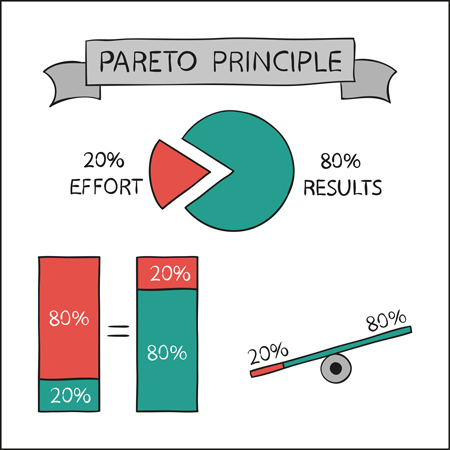What are the benefits of the 80/20 principle for both enterprises and individuals?
Have you ever heard of the “80/20 Principle”? If you have never heard of it or have heard of it but do not understand the nature and benefits of implementing this principle in your enterprise, you can find out in this article.
Table of Content
1. How to properly understand the 80/20 principle?

The 80/20 principle (also known as the Pareto rule) is a principle named after the Italian economist V.F. Damaso Pareto, based on his work from the late 19th century, which points out the “incongruity balance” between the effort we put in and the results we get.
Originally, the Pareto Principle referred to the test result that 80% of Italy’s assets were owned by 20% of the population. Later, more generally, the Pareto Principle became famous and known as the 80/20 Principle, meaning that the vast majority of things in life are not equally distributed: About 80% of the results are due to 20% causes. In other words, about 80% of work results or outputs come from only 20% of efforts or inputs. Thanks to this principle, enterprises can know the strengths and weaknesses in their management circle to come up with appropriate strategies.
To better understand the 80/20 principle, you can refer to the case of IBM, a pioneer multinational corporation successfully that applied this principle.
In the period starting in 1963, insiders found that 20% of the code worked 80% of the time on a computer (an IBM product). Immediately, they implemented new software that optimized 20% encryption for continuous use and was user-friendly. This helps their output computers work faster than other products on the market.
From the above results, you can understand that optimizing 20% of the software will improve 80% of computer performance, which is also the best illustration of the 80/20 principle. Thanks to the success of IBM, other famous corporations such as Apple and Microsoft have applied the 80/20 rule to the production lines of computers and enterprise software to optimize costs and be user-friendly including those who are not good at technology can still use it.
Besides, you can also understand more about the principle from some statements such as:
- 80% of sales come from 20% of customers
- 80% of product demand comes from 20% of feature upgrades
- 20% of the company’s main products come from 80% of employees’ efforts
- 80% of work performance comes from 20% of corporate employees
The 80/20 principle is one of the most applied theories in management and production to improve output quality, as well as find optimal solutions to enterprise weaknesses.
2. How does the 80/20 principle apply to enterprises and individuals?
2.1 Benefits of applying the 80/20 principle in enterprises
The Pareto Principle helps you build the motivation to focus your efforts on the 20% of the factors that make your enterprises different, instead of spreading it around the 80% that doesn’t yield much.

- In labor productivity management: In an enterprise, 20% of the product focus can bring up to 80% of sales, or 80% of the value of a product or service comes from 20% of its important features. This proves that the input and output values are always unbalanced. Applied in practice, businesses can focus their resources on this 20% to create the expected results.
- In providing products: Enterprises need to have 20% of products/services considered as core and invest up to 80% of time and effort. Even within the same product, the 20% of the features considered most important hold 80% of its value. Production, marketing, and sales teams should focus on this feature group when introducing it to customers.
- In time management: Spend 80% of your time on 20% of the tasks that have the greatest impact on the survival of the enterprise. Rooted in economic thinking, the 80/20 Rule is widely used in enterprise and production. The Pareto Principle effectively supports managers in deciding the optimal allocation of time and resources. Instead of spreading out at 80% without getting much results, it is better to focus your efforts on the 20% factors that make the enterprise different.
- In inventory management: In enterprises, you discover that 80% of inventory costs come from 20% of customers. If the cause of the problem can be found, the company’s inventory costs will be significantly reduced, thereby optimizing revenue.
- In customer management: 80% of the enterprise’s revenue comes from 20% of the focus customers. Many enterprises mistakenly believe that all customers are the same and should be treated equally. However, the reality proves that there will be customer groups that bring more benefits to the enterprise than the rest. Therefore, defining a strategy for 20% of the focus customers is essential for every business. Instead of taking care of all customers spread out, enterprises will care more about 20% of this customer group, find out what they like, what their needs are, need to reserve rights incentives to increase the loyalty of this customer group.
- In management, motivate employees: 20% of excellent employees in the company bring 80% of revenue or enterprise performance for the business. Therefore, having a policy to reward and motivate this group of employees is essential to improve the performance of the whole system.
- In customer service: Sticking to the 80/20 model, you’ll also see 80% of customer complaints and enterprise losses stemming from 20% of certain defects. Focusing on correcting these urgent defects will improve the enterprise’s situation for enterprises.
2.2 Benefits of applying the 80/20 rule to individuals:
- The 80/20 Rule help with time management: You need to prioritize your tasks. Then spend 80% of your time dealing with 20% of the most important tasks. After completing these tasks, you should proceed to do other tasks according to the set list or delegate to junior staff to do.
- The 80/20 Rule helps screen relationships: Applying the 80/20 rule will help you find the 20% of relationships that bring 80% of your happiness and value to your life. From there, you can spend 80% of your time on this group of positive relationships and less time on other social relationships
- The 80/20 Rule in cultivating self-knowledge: Identify personal goals and knowledge to be cultivated. Then focus 80% of the time on the 20% most important categories. The rest of the time is spent on less important elements.
Hopefully, the above content has helped you to better understand the 80/20 principle, also known as Pareto’s rule, and know how to optimize benefits effectively when applied in work and life. You can continue to follow BEMO’s articles to update more useful knowledge.














